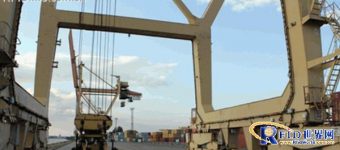
Latvia container terminal uses UHF RFID technology to track containers
[ad_1]
The Port of Riga in Latvia is based onRFID technologyThe asset tracking system effectively locates the inbound and outbound containers. The realization of the solution is mainly based on the crane with the RFID reader. The RFID asset tracking solution is provided by Autepra.
Baltic Container Terminal (BTC for short) is one of the important loading and unloading areas in the port of Riga, Latvia. It has adopted a container management solution based on RFID automatic identification technology. This solution uses multiple identification technologies to track and locate containers, tractors, etc. in the terminal, so as to better manage the cargo in and out of the terminal. In addition to using passive UHF RFID technology, it also includes a variety of recognition software such as cameras and optical character recognition (OCR) to effectively locate containers loaded and unloaded by gantry cranes.
BCT has three gantry cranes, which can serve three ships at the same time and can supply 12 trailers for freight. The terminal freight container includes two kinds of 20 and 40 inches, and the trailer is used to transport the container from the cargo ship. At the beginning of this year, before installing the automatic identification and tracking system, BCT needed a loading and unloading counterman to record the ID code on the container, the code of the tractor and other data in the palm computer. Then check whether the container is intact and make a record. After completing the above operations, the loading and unloading counting worker announces that the container can be transported.

One RFID reader and four antennas are installed on each side of the crane
Approximately 40 containers enter or leave the port every hour. For containers that are about to be shipped out of the port, manual data recording and completeness checks are also required.
Traditional container management solutions require three loading and unloading counters to work 24 hours a day to perform tasks, which requires a lot of labor costs. In addition, there are certain loopholes in manual inspection, and there are certain threats to the safety of workers.
The automated asset tracking solution provided by Autepra uses cameras, optical character recognition (OCR) and other technologies to ensure reasonable loading of containers. Among them, the camera can capture images of all sides of the container to ensure the comprehensiveness and authenticity of the integrity inspection.
Two Omni-ID Dura 3000 UHF are installed on each tractorRFID tags, The unique ID code of the tag used to identify the tractor is stored in the terminal’s back-end server, which integrates the terminal operating system (TOS).
Each crane is equipped with two fixed CAEN RFID R4300P-ION readers, one is installed on the outside of the crane, and the other is installed on the inside of the crane bracket. The entire crane is installed on the track to facilitate the movement of the crane between the cargo ship and the cargo loading area. There are three lanes under the crane, the middle lane is used for loading and unloading goods, and the lanes on both sides are used for the passage of tractors.
After the automatic asset solution based on RFID technology is installed and implemented, when the tractor enters the middle lane under the crane to load and unload goods, the RFID reader reads the RFID tag on the tractor. In addition to the reader, four antennas are installed,antennaThe installation helps to check whether the tractor stays in the proper position and whether the running direction is correct. If the position of the tractor is reasonable, the crane will load or unload the goods.
The system can determine whether the tractor simply passes by or is about to load and unload goods. Only when a tag is read, it proves that the tractor is only passing.
In the next few months, the tractor will be equipped with a computer, mainly used to display the information of the container has been shipped and whether an error has occurred. For example, when the driver parks the tractor in the wrong lane, the system will prompt that the RFID code of the tractor does not match its location, and at the same time, an alarm will be issued to remind the driver to move.
The asset tracking solution based on RFID technology also realizes the automation of container integrity inspection, and provides sufficient evidence to prove whether it is damaged by taking pictures. The container terminal hopes that the full adoption of this program can reduce the amount of labor in the management of loading and unloading containers.
Of course, the installation of this RFID-based asset tracking solution has certain challenges, mainly because the transmission of information between the tag and the reader is hindered to a certain extent.
[ad_2]



